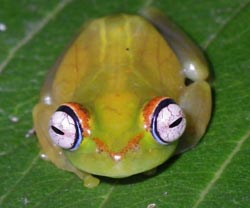Molecular clocks decipher the origin of Madagascar's unique fauna

Treefrog from northern Madagascar's rainforest (Boophis sambirano). This species belongs to a large radiation of frogs that probably colonized Madagascar from Asia, about 60-70 million years ago. Photo: Miguel Vences<br>
The World's fourth largest island reminds a large open-air museum and a sanctuary of nature. No other region on Earth contains such a high number of endemic species, that is, species that occur only on Madagascar and nowhere else.
But how did these remarkable animals arrive on Madagascar? For long time, this question was unsolved and had been considered to be one of the largest biogeographic mysteries. Madagascar is isolated since the Cretaceous period from all other continents. Fossils from the end of that period, around 70 million years old, suggest a very different assemblage of ancient animals without any obvious relationships to Madgascar's current fauna: dinosaurs and marsupial mammals, lungfishes and gars, vegetarian crocodiles and giant toads walked on the island in that period.
Many species colonized Madagascar 60-70 million years before present
German researchers of the University of Braunschweig (TU Braunschweig) have worked for many years on the origins of Madagascar's unique animals, and this originally puzzling question has now been largely solved. In two articles published in parallel in the renowned scientific journal “Proceedings of the National Academy of Sciences of the USA (PNAS)” two research teams analyse the origins of Madagascar's vertebrates. The molecular genetic data generated in Braunschweig allowed to apply a so-called “molecular clock” dating of the colonization history and revealed that the origins of almost all of these unique animals are comparatively young, geologically speaking. “The ancestors of most of the striking animals attracting today's tourists to Madagascar arrived on the island around 60-70 million years before present. They all rafted over the ocean, mainly out of Africa” comments Prof. Miguel Vences who led the German team of researchers.
Probably during large thunderstorms, rafts such as big trees in Africa and Asia, were torn into the sea and some of them eventually arrived on Madagascar's shores – along with some miraculously surviving animals that found themselves like ancient versions of Robinson Crusoe in a totally unknown environment to which many of them succeeded to adapt.
Humans, the most dangerous species, reached Madagascar only 2000 years ago
The overseas dispersal theory is also supported by a second set of analyses: Statistically, Asian animals arrived on Madagascar mainly in ancient times when when only a low sea strait separated the two land masses. And colonizations from Africa became rare after a change in the regime of prevailing winds: Large storms, named Cyclones in the Indian Ocean, are an effective means to push large rafts such as trees over the ocean, but at present they typically move in the “wrong” direction, from Madagascar to Africa, and therefore do not favor colonizations. For about 15 million years, only very new new animal groups arrived in Madagascar, and the fauna of the island therefore could evolve in almost complete isolation, evolving the amazing specializations that we observe today. The most influential factor in their diversification was the tropical rainforest: Only those animal groups that adapted to this habitat succeeded in diversifying into the striking variety of species typical for Madagascar.
One animal, however, managed to arrive in very recent times to Madagascar: Humans only arrived in Madagascar about 2000 years ago and quickly disturbed the fragile ecosystem of the island. At that time, giants walked on Madagascar: giant tortoises, giant lemurs and giant flightless birds – all were hunted to extinction by humans within a few centuries. And today, the majority of Madagascar's unique wildlife are at risk by slash-and-burn agriculture, illegal logging and hunting. “Only intensified efforts of nature conservation can save this nature sanctuary that was assembled over a long period of 70 million years by animals stranding on its shores.”, adds Angelica Crottini a biologist who did most of the laboratory analyses at Braunschweig.
Crottini, A., O. Madsen, C. Poux, A. Strauß, D.R. Vieites, M. Vences (2012): Vertebrate time-tree elucidates the biogeographic pattern of a major biotic change around the K–T boundary in Madagascar. – Proceedings of the National Academy of Sciences of the USA, in press.
doi/10.1073/pnas.1112487109
Samonds, K.A., L.R. Godfrey, J.R. Ali, S.M. Goodman, M. Vences, M.R. Sutherland, M.T. Irwin, D.W. Krause (2012) Spatial and temporal arrival patterns of Madagascar’s vertebrate fauna explained by distance, ocean currents, and ancestor type. – Proceedings of the National Academy of Sciences of the USA, in press.
doi/10.1073/pnas.1113993109
Contact: Prof. Dr. Miguel Vences
Zoologisches Institut der Technischen Universität Braunschweig
Mendelssohnstr. 4, 38106 Braunschweig
Tel.: +49 (0)531 391 3237
E-Mail: m.vences@tu-braunschweig.de
http://www.mvences.de/
This press release is accompanied by a series of 12 photographs of representatives Madagascar's unique wildlife, along with short captions.
High-resolution versions of the same photographs can be downloaded at the following link: http://www.mvences.de/Vences_press_release_2012_photos.zip
Media Contact
More Information:
http://www.tu-braunschweig.deAll latest news from the category: Ecology, The Environment and Conservation
This complex theme deals primarily with interactions between organisms and the environmental factors that impact them, but to a greater extent between individual inanimate environmental factors.
innovations-report offers informative reports and articles on topics such as climate protection, landscape conservation, ecological systems, wildlife and nature parks and ecosystem efficiency and balance.
Newest articles

Magnetic Memory Unlocked with Energy-Efficient MRAM
Researchers from Osaka University introduced an innovative technology to lower power consumption for modern memory devices. Stepping up the Memory Game: Overcoming the Limitations of Traditional RAM Osaka, Japan –…

Next-Level System Security: Smarter Access Control for Organizations
Cutting-Edge Framework for Enhancing System Security Researchers at the University of Electro-Communications have developed a groundbreaking framework for improving system security by analyzing business process logs. This framework focuses on…

How Microbial Life Shapes Lime Formation in the Deep Ocean
Microorganisms are everywhere and have been influencing the Earth’s environment for over 3.5 billion years. Researchers from Germany, Austria and Taiwan have now deciphered the role they play in the…



